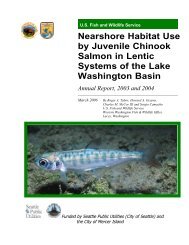2006 Water Comprehensive Plan - City of Bellevue
2006 Water Comprehensive Plan - City of Bellevue
2006 Water Comprehensive Plan - City of Bellevue
- No tags were found...
Create successful ePaper yourself
Turn your PDF publications into a flip-book with our unique Google optimized e-Paper software.
surface waters, establishing requirements for Giardia lamblia, viruses, Legionella, heterotrophicbacteria, and turbidity levels <strong>of</strong> treated water.After treatment, the SWTR requires a minimum disinfectant residual <strong>of</strong> 0.2 mg/L at the point <strong>of</strong>entry to the distribution system at all times. Additionally, a detectable disinfectant residual mustbe present in at least 95% <strong>of</strong> all distribution system samples collected at the same location andfrequency as samples collected for compliance with the Total Coliform Rule. Alternatively,samples may be analyzed for heterotrophic bacteria using the plate count method (HPC). AnHPC level <strong>of</strong> 500 colony forming units per mL (cfu/mL) or less is considered equivalent to adetectable disinfectant residual.<strong>Bellevue</strong> Status<strong>Bellevue</strong> samples chlorine residual 84 times each month at 23 sites throughout the distributionsystem. Between 1998 and 2004, chlorine residual was always detectable in at least 95% <strong>of</strong>samples collected at total coliform sampling stands. In addition, between 2000 and 2004,<strong>Bellevue</strong> collected 410 HPC samples throughout the distribution system. Of these, the maximumHPC result was 49 cfu/mL and nearly 88% <strong>of</strong> the collected samples contained 0 cfu/mL.Total Coliform RuleRegulatory RequirementsThe Total Coliform Rule (TCR) requires systems to monitor their distribution system forcoliforms, which are bacteria used to indicate the presence <strong>of</strong> potentially harmful bacteria suchas E. coli. Under this rule, there are two types <strong>of</strong> violations: acute and non-acute. An acuteMCL violation for coliform is the presence <strong>of</strong> fecal coliform or E. coli in a repeat sample, orcoliform presence in a repeat sample collected as a follow-up to a sample indicating the presence<strong>of</strong> fecal coliform or E. coli. A non-acute MCL violation for coliform occurs when a system thatcollects 40 or more coliform samples per month has more than 5.0% <strong>of</strong> the routine samples takenin one month test positive for the presence <strong>of</strong> total coliform.<strong>Bellevue</strong> Status<strong>Bellevue</strong> is one <strong>of</strong> approximately 27 water systems and districts that receive water from sourcestreated and operated by SPU. SPU and its wholesale customers have been part <strong>of</strong> a regional,DOH-approved, coliform monitoring program since 1972. As part <strong>of</strong> the regional program,wholesale customers are responsible for installing and maintaining designated coliformmonitoring sample stands, while SPU collects the monthly samples. Under this agreement, SPUand its purveyors sample at a rate <strong>of</strong> 70% <strong>of</strong> samples required by the Total Coliform Rule.<strong>Bellevue</strong> currently supplies water to a population <strong>of</strong> approximately 134,000, therefore, theminimum number <strong>of</strong> routine samples collected within <strong>Bellevue</strong>’s distribution system is 84 permonth (70% <strong>of</strong> the 120 samples required for systems serving 130,001 to 220,000 customers).According to the regional monitoring plan, SPU collects routine samples. <strong>Bellevue</strong> is10-6
















